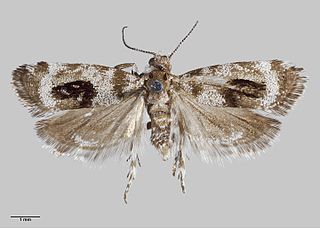
Asterivora inspoliata is a species of moth in the family Choreutidae. It is endemic to New Zealand and has been found in the southern parts of the South Island. Adults are on the wing in December and January.

Asterivora tristis is a species of moth in the family Choreutidae. It is endemic to New Zealand and has been observed in Tongariro National Park. Adults of this species are on the wing in January.

Cryptaspasma querula is a moth of the family Tortricidae. It is endemic to New Zealand and can be found throughout the country. This species inhabits podocarp and broadleaf forest. The larvae consume parts of the seeds and fruits of tawa, tarairi and miro trees and are predated upon by the invasive to New Zealand house mouse. Adults are variable in appearance and also in size. They are on the wing throughout the year and are nocturnal but are attracted to light. They can be found having flown inside houses and have also been observed resting on fences or other human made structures during the day.

Izatha balanophora is a moth of the family Oecophoridae. It is endemic to New Zealand, where it is widespread in the North Island. Larvae live off the dead bark of kānuka. The adult moths are on the wing during December to March.

Batrachedra astricta is a species of moth in the family Batrachedridae. It is endemic to New Zealand. It is found in the north of the North Island and also Opoho in Otago. This species is on the wing in December. B. astricta has been found in wetland habitat. It has been shown to be associated with the threatened plant Sporadanthus ferrugineus.

Batrachedra litterata is a species of moth in the family Batrachedridae. It is endemic to New Zealand and has been collected in the North and South Islands. This species has been reared on the fern species Blechnum chambersii. Adults are on the wing in November and December.

Planotortrix notophaea, the blacklegged leafroller, is a species of moth in the family Tortricidae. It is endemic to New Zealand. It was also present near Sydney in Australia, but this population is thought to be extinct.

Epichorista tenebrosa is a species of moth in the family Tortricidae. This species is endemic to New Zealand. It is found in Otago and has been collected in tussock grassland habitats. It is a late autumn emerging moth and adults are on the wing in February. It is classified as "At Risk, Relict'" by the Department of Conservation.

Pyrgotis arcuata is a species of moth of the family Tortricidae. It is endemic to New Zealand.

Pyrgotis consentiens is a species of moth of the family Tortricidae. It is endemic to New Zealand. The holotype specimen of P. consentiens is held at the New Zealand Arthropod Collection (NZAC). Specimens of this species have also been collected on Stewart Island as well as in the Hunter Mountains.

Pyrgotis eudorana is a species of moth of the family Tortricidae. It is endemic in New Zealand and has been observed in both the North and South Islands. However it is regarded as a rare insect. This species inhabits native forest. Larvae exclusively feed on Muehlenbeckia australis and adults are on the wing from November to April. Adults are attracted to light.

Pyrgotis pyramidias is a species of moth in the family Tortricidae. It is endemic to New Zealand. It is classified as "At Risk, Naturally Uncommon" by the Department of Conservation. This species is regarded as having two 'forms' although doubt has been expressed whether these are the same species.

Pyrgotis transfixa is a species of moth of the family Tortricidae. It is endemic to New Zealand. It is classified as "At Risk, Naturally Uncommon" by the Department of Conservation.

Acroclita discariana is a species of moth in the family Tortricidae. It is endemic to New Zealand. It is classified as Nationally Vulnerable by the Department of Conservation.

Archyala culta is a species of moth in the family Tineidae. This species is endemic to New Zealand. It is classified as "Data Deficient" by the Department of Conservation. This species has only been collected at Opoho and is only known from its type specimen.

Trachypepla nimbosa is a species of moth in the family Oecophoridae. It is endemic to New Zealand. This species has been collected in Auckland as well as one specimen in the West Coast. Adults are on the wing in January however the West Coast specimen was collected in November. This species is classified as "Data Deficient" by the Department of Conservation.

Trachypepla festiva is a moth of the family Oecophoridae and was first described by Alfred Philpott in 1930. It is endemic to New Zealand and has been collected in the northern parts of the North Island.

Tingena laudata is a species of moth in the family Oecophoridae. It is endemic to New Zealand and has been observed in Fiordland and Otago. Adults of this species are on the wing in January.

Tingena levicula is a species of moth in the family Oecophoridae. It is endemic to New Zealand.

Trachypepla minuta is a moth of the family Oecophoridae first described by Alfred Philpott in 1931. It is endemic to New Zealand and has been collected in Auckland. Adults of this species are on the wing in December. It is distinguishable from similar species as it is smaller in size and darker in appearance than other species in the genus Trachypepla.




















